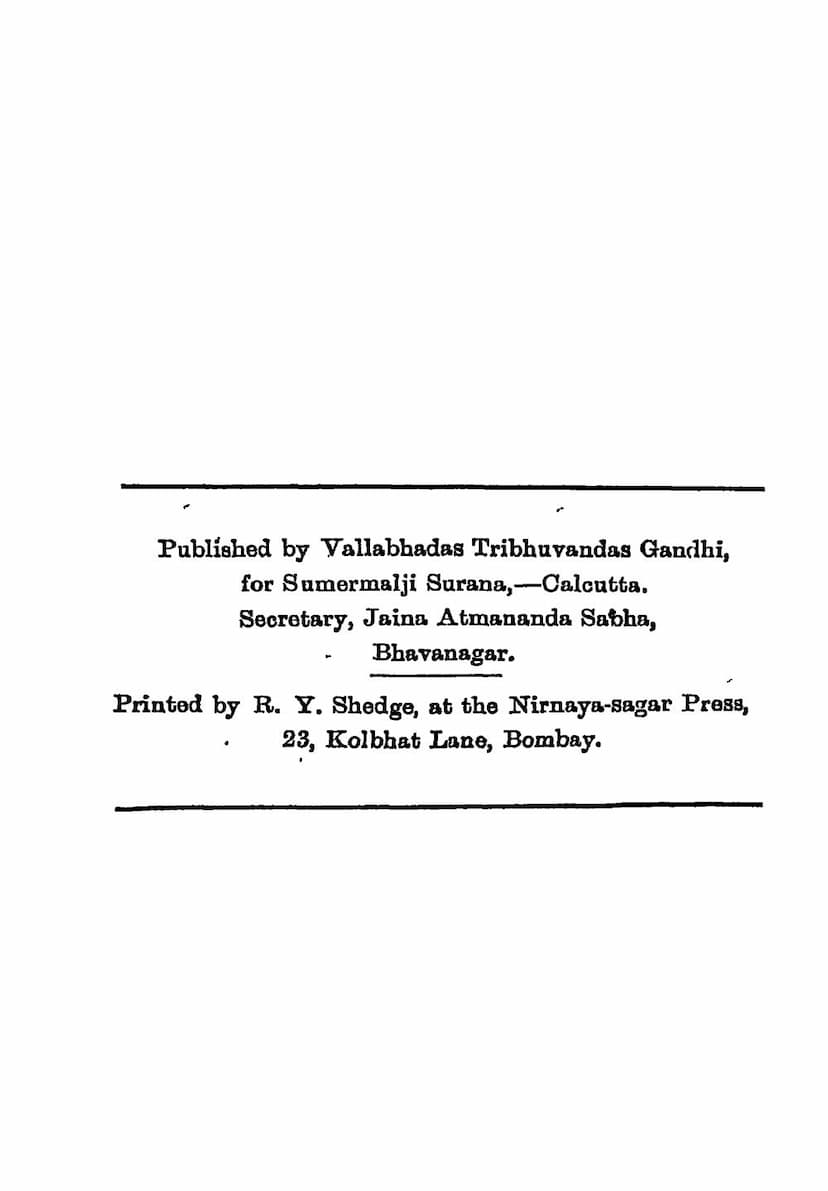Chaturvinshati Jinstavan
Added to library: September 1, 2025

Summary
This comprehensive summary is based on the provided Jain text, "Chaturvinshati Jinstavan" by Atmaramji Maharaj, published by Jain Shastramala Karyalay. The text is a collection of devotional hymns (Stavans) dedicated to the 24 Tirthankaras (Jinas) in Jainism.
Overall Purpose and Structure:
The book is primarily a collection of stavans (hymns of praise and devotion) composed in Gujarati, with each stavan dedicated to a specific Tirthankara. The purpose is to foster devotion and contemplation among Jain followers by glorifying the virtues and deeds of the Tirthankaras. The structure is systematic, generally presenting the stavans in the order of the Tirthankaras' succession.
Author and Context:
The preface highlights the significant contribution of Mahatma Shri Vijayanand Suri (also known as Atmaramji Maharaj) in writing numerous books on Jain philosophy and devotional worship. It mentions that Atmaramji Maharaj authored many pujas (rituals of worship), and this collection of stavans further enhances his contribution. The book also includes works by his disciple, Upadhyayji Shri Vir Vijayji Maharaj, who followed in his footsteps to benefit the community. The text emphasizes that reading and contemplating these hymns is a means to spiritual progress and the shedding of karmas.
Content - The 24 Jinstavans:
Each stavan typically follows a lyrical structure, often set to traditional folk melodies (indicated by "एदेशी" or "ए चाल"), making them accessible for singing and recitation. The content of each stavan focuses on:
- Praise of the Tirthankara: Glorifying their divine qualities, such as infinite knowledge (Anant Gyan), infinite perception (Anant Darshan), infinite conduct (Anant Charitra), infinite bliss (Anant Sukh), immense strength (Anant Bal), and their role as spiritual guides.
- Life Events and Attributes: Mentioning key events in their lives, such as their birth, renunciation, attainment of omniscience (Keval Gyan), and their celestial status. Specific attributes like their lineage, symbols, and the celestial trees under which they attained enlightenment are often referenced.
- Devotee's Supplication: The hymns often express the devotee's earnest prayers for liberation from the cycle of birth and death (Samsara), freedom from karma, attainment of spiritual merit, and guidance towards the right path (Samyak Darshan, Samyak Gyan, Samyak Charitra). The devotee often expresses feelings of helplessness, reliance on the Tirthankara's grace, and a desire for spiritual awakening.
- Philosophical Concepts: While primarily devotional, the stavans subtly weave in core Jain philosophical concepts like:
- Vitaraga (Freedom from Passion): The Tirthankaras are praised for their detachment from worldly passions like anger, pride, deceit, and greed.
- Karma: The hymns frequently mention the burden of karma, the cycle of birth and death caused by karma, and the Tirthankaras' ability to guide devotees in shedding these karmas.
- Moksha (Liberation): The ultimate goal of spiritual practice, liberation from all suffering and the cycle of rebirth, is a recurring theme.
- Samyak Darshan, Gyan, Charitra: The path to liberation, consisting of right faith, right knowledge, and right conduct, is implicitly or explicitly mentioned.
- Syadvada (The Doctrine of Manifold Aspects): Some stavans might allude to the Tirthankaras' teachings on the multi-faceted nature of reality.
Key Themes Across the Stavans:
- The Tirthankaras as Saviors: They are consistently portrayed as spiritual saviors who guide beings out of the ocean of suffering caused by karma and worldly attachments.
- The Transience of Worldly Life: The stavans often highlight the impermanence of life, youth, wealth, and relationships, urging the devotee to focus on spiritual pursuits.
- The Power of Devotion: Singing, reciting, and meditating on the names and virtues of the Tirthankaras are presented as powerful means to spiritual progress and the purification of the soul.
- The Importance of the Guru: The preface and the inclusion of disciple's works emphasize the role of the Guru in spiritual guidance.
Specific Examples (Illustrative):
- Shri Rishabh Jin Stavan: Praises Rishabhadeva as the first Tirthankara, describing his celestial beauty and the auspiciousness of his presence.
- Shri Ajitnath Jin Stavan: Appeals to Ajitnath to help overcome the ocean of birth and death and the burden of karma.
- Shri Mahavir Jin Stavan: Celebrates Mahavir Swami as the last Tirthankara, highlighting his teachings and his role in dispelling ignorance.
- General/Common Stavans: The collection also includes general stavans that can be sung in praise of any Tirthankara, often focusing on universal Jain principles.
Additional Sections:
The text also includes a section on "Dwadash Bhavna" (Twelve Reflections), which are standard contemplative verses in Jainism covering topics like the impermanence of life, the suffering of the world, the uniqueness of the self, the impurities of the body, the inflow and stoppage of karma, and the path to liberation.
Publisher and Printing:
The book was published by Vallabhadas Tribhuvandas Gandhi for Sumermalji Surana, Calcutta, and printed by R. Y. Shedge at the Nirnaya-sagar Press, Bombay.
In essence, "Chaturvinshati Jinstavan" is a devotional treasury, offering a lyrical and accessible way for Jain devotees to connect with the spiritual teachings and exemplary lives of the 24 Tirthankaras, fostering a path towards liberation.